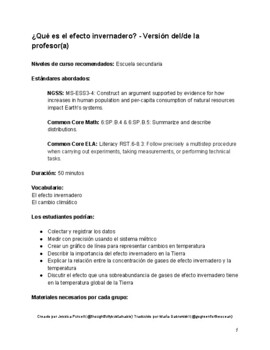¿Qué es el efecto invernadero? (What is the Greenhouse Effect?)
108 Downloads
Thoughtfully Sustainable
32 Followers
Grade Levels
6th - 12th, Homeschool
Subjects
Resource Type
Standards
CCSS6.SP.B.4
CCSS6.SP.B.5
CCSSRST.6-8.3
NGSSMS-ESS3-4
NGSSMS-ESS3-3
Formats Included
- PDF
Pages
11 pages
Thoughtfully Sustainable
32 Followers
Description
This is a terrific way to visualize the greenhouse gas effect and begin discussions about human-induced climate change. Both teacher and student versions of this lesson are written in Spanish. For an English version of this lesson, please visit my store!
Total Pages
11 pages
Answer Key
Included
Teaching Duration
50 minutes
Last updated Sep 6th, 2020
Report this resource to TPT
Reported resources will be reviewed by our team. Report this resource to let us know if this resource violates TPT’s content guidelines.
Standards
to see state-specific standards (only available in the US).
CCSS6.SP.B.4
Display numerical data in plots on a number line, including dot plots, histograms, and box plots.
CCSS6.SP.B.5
Summarize numerical data sets in relation to their context, such as by:
CCSSRST.6-8.3
Follow precisely a multistep procedure when carrying out experiments, taking measurements, or performing technical tasks.
NGSSMS-ESS3-4
Construct an argument supported by evidence for how increases in human population and per-capita consumption of natural resources impact Earth’s systems. Examples of evidence include grade-appropriate databases on human populations and the rates of consumption of food and natural resources (such as freshwater, mineral, and energy). Examples of impacts can include changes to the appearance, composition, and structure of Earth’s systems as well as the rates at which they change. The consequences of increases in human populations and consumption of natural resources are described by science, but science does not make the decisions for the actions society takes.
NGSSMS-ESS3-3
Apply scientific principles to design a method for monitoring and minimizing a human impact on the environment. Examples of the design process include examining human environmental impacts, assessing the kinds of solutions that are feasible, and designing and evaluating solutions that could reduce that impact. Examples of human impacts can include water usage (such as the withdrawal of water from streams and aquifers or the construction of dams and levees), land usage (such as urban development, agriculture, or the removal of wetlands), and pollution (such as of the air, water, or land).





